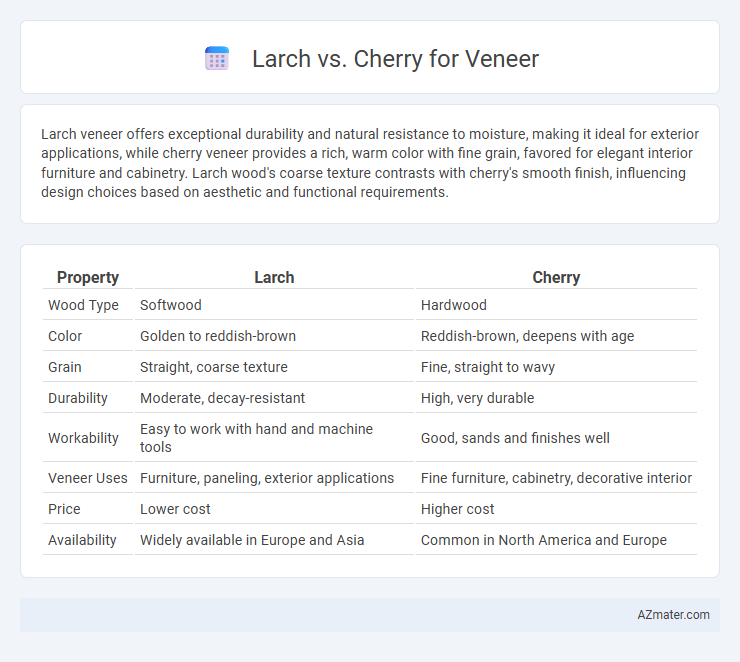Larch veneer offers exceptional durability and natural resistance to moisture, making it ideal for exterior applications, while cherry veneer provides a rich, warm color with fine grain, favored for elegant interior furniture and cabinetry. Larch wood's coarse texture contrasts with cherry's smooth finish, influencing design choices based on aesthetic and functional requirements.
Table of Comparison
| Property | Larch | Cherry |
|---|---|---|
| Wood Type | Softwood | Hardwood |
| Color | Golden to reddish-brown | Reddish-brown, deepens with age |
| Grain | Straight, coarse texture | Fine, straight to wavy |
| Durability | Moderate, decay-resistant | High, very durable |
| Workability | Easy to work with hand and machine tools | Good, sands and finishes well |
| Veneer Uses | Furniture, paneling, exterior applications | Fine furniture, cabinetry, decorative interior |
| Price | Lower cost | Higher cost |
| Availability | Widely available in Europe and Asia | Common in North America and Europe |
Introduction to Larch and Cherry Veneers
Larch veneer is prized for its durability, tight grain, and warm reddish-brown hues, making it a preferred choice for robust, rustic interior designs. Cherry veneer offers a smooth texture with fine, straight grain and a rich, reddish-brown color that deepens with age, ideal for elegant furniture and cabinetry. Both larch and cherry veneers provide distinctive aesthetic and structural qualities that cater to diverse woodworking and architectural applications.
Botanical Overview: Larch vs Cherry Trees
Larch (genus Larix) is a deciduous conifer known for needle-like leaves that turn golden in autumn before shedding, while Cherry (genus Prunus) is a deciduous hardwood tree bearing broad, glossy leaves and distinctive flowers. Larch trees grow primarily in cooler northern hemisphere regions, exhibiting strong resistance to rot and moisture, making their veneers durable and stable. Cherry trees, native to temperate regions, produce fine-grained, reddish-brown wood prized for its smooth texture and rich color changes over time in veneer applications.
Appearance and Grain Patterns
Larch veneer exhibits pronounced, straight grain patterns with a warm reddish-brown hue that darkens over time, offering a rustic and textured aesthetic ideal for natural, earthy interiors. Cherry veneer features fine, smooth grains with a uniform, rich reddish tone that deepens to a luxurious mahogany shade, providing an elegant and classic appearance favored in high-end furniture. Both woods showcase distinct grain patterns, but larch's rougher texture contrasts with cherry's sleek, refined finish, making each suitable for different design styles.
Color Variations and Aging
Larch veneer displays a warm golden to reddish-brown hue that deepens gracefully with age, developing a rich patina that enhances its natural grain patterns. Cherry veneer starts with a light pinkish tone that progressively darkens to a deep reddish-brown, creating a sophisticated, aged appearance over time. Both woods exhibit unique color variations, but cherry's uniform aging process offers a more predictable and elegant transformation compared to the dynamic shifts seen in larch.
Durability and Hardness Comparison
Larch veneer exhibits high durability and natural resistance to decay due to its dense, resin-rich composition, making it suitable for both indoor and outdoor applications. Cherry veneer, while prized for its rich color and smooth grain, offers moderate hardness and less resistance to wear compared to larch, often requiring protective finishes to enhance longevity. The Janka hardness rating for larch ranges from 830 to 980, surpassing cherry's 950, indicating slightly better resistance to dents and scratches in larch veneers.
Workability and Finishing Qualities
Larch veneer offers excellent workability due to its uniform texture and moderate hardness, making it easy to cut, sand, and shape without splintering. Cherry veneer, prized for its fine grain and natural luster, allows smooth finishing with a warm, rich patina that deepens over time. Both veneers respond well to staining and polishing, but cherry's superior oil absorption enhances color depth and finish durability.
Common Applications in Veneering
Larch veneer is commonly used in rustic and exterior furnishings due to its natural durability and coarse grain, making it ideal for cabinetry, paneling, and decorative surfaces that require robustness. Cherry veneer, prized for its smooth texture and rich reddish-brown color, is frequently applied in high-end furniture, interior millwork, and luxury cabinetry where an elegant and refined finish is desired. Both veneers offer distinct aesthetic and functional qualities, with larch favored for structural and outdoor applications and cherry preferred for upscale, polished interiors.
Cost and Availability
Larch veneer generally offers a more cost-effective option compared to cherry, as larch trees grow faster and are more abundant in regions like northern Europe and parts of North America. Cherry veneer, prized for its rich color and fine grain, tends to be more expensive due to slower growth rates and higher demand in luxury woodworking markets. Availability of larch veneer is more consistent year-round, while cherry veneer supply can fluctuate with seasonal harvesting and market trends.
Environmental and Sustainability Considerations
Larch veneer offers a more sustainable choice due to its faster growth rate and higher carbon sequestration compared to Cherry, which grows slower and requires longer harvesting cycles. Larch wood is often sourced from well-managed forests in Northern Europe, promoting biodiversity and reducing ecological impact, whereas Cherry is predominantly harvested in North America with varying sustainability certifications. Choosing Larch veneer supports eco-friendly manufacturing by minimizing deforestation and promoting renewable resources, aligning with green building standards.
Choosing Between Larch and Cherry Veneer
Larch veneer offers exceptional durability and a distinctive grain pattern with natural resinous qualities, making it ideal for rustic or outdoor-inspired designs, while cherry veneer provides a smoother texture and warm reddish hue, favored for elegant and refined interiors. Choosing between larch and cherry veneer depends on the desired aesthetic and functional requirements; larch excels in resistance to wear and moisture, whereas cherry ages gracefully, developing a rich patina over time. Cost considerations and availability may also influence the decision, as cherry veneer tends to be more expensive but highly sought after for high-end woodworking projects.

Infographic: Larch vs Cherry for Veneer
 azmater.com
azmater.com